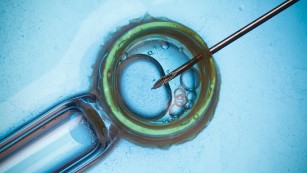"Three-Parent Babies"
"[The DNA blending technique represents a] novel, promising intervention [allowing women to avoid the potential of children inheriting fatal diseases, and as such should not be forbidden by law resulting from] misplaced apprehension [of interfering with the human genome."
"[Canadians] have the right to benefit from scientific advances [under the Universal Declaration of Human Rights]."
"[The procedure, mitochondrial replacement therapy: MRT], is often the only possible intervention to enable the birth of a healthy, genetically related child for women who carry [mitochondrial mutations]."
"The desire -- and social pressure -- to conceive biological children have been subjects of rich theoretical and health policy inquiry. [The media's reporting of assisted-baby-making techniques] has played no small part in contemporary social constructions of assisted reproduction as being antithetical to 'natural' processes of conception and parenting."
Journal of Obstetrics and Gynaecology Canada commentary
"Were not advocating that anybody can do anything. We're advocating that this should be allowed to go forward."
"Because right now it's impossible because of criminal law -- if you do this, there are jail times and fines, period."
"We can set up an ethical framework and protect Canadians from the sorts of cowboys like Zhang."
"People might say we don't know what the impact of the change is on the children born. What we're saying is, this is one of many discoveries and techniques that are coming, and we don't have a framework whereby we can say whether we should or shouldn't do it."
Dr. Arthur Leader, Ottawa fertility specialist
 |
| Controversial 3-parent baby technique: image media |
The "Zhang" referenced was to Manhattan-based Dr. John Zhang who has set up his own commercial enterprise providing a form of MRT, promising to guide women in their 40s toward carrying their very own biological babies. Their DNA undergoes a technique whereby it is inserted into younger, fresher eggs provided by younger women at his New Hope Fertility Center. The facility Dr. Zhang opened operates with a stable of fertility doctors able, at a substantial cost, to 'give hope' to women past their normal child-bearing years.
In fact, Dr. Zhang and his clinic have been issued a warning by the U.S. Food and Drug Administration that the technique has not been formally approved for use, and he must cease and desist from promoting and providing his controversial "spindle nuclear transfer" technique. The vast majority of a cell's genetic material (DNA) resides within its nucleus, with an amount less than 1% found in the mitochondria, which in its intact state is passed from mother to child through her egg.
With this technique, less than 0.1% of DNA comes from the donor egg, with the balance of 99.9% contributed by the mother whose DNA the child inherits, while the potential for inheriting a mutation is removed through the process. The ethics involved in this technique is the concern that the process will be used for cosmetic reasons, not reasons linked to avoiding dangerous mutations. And that eventually with the loosening of standards, the technique will ultimately be used to 'design' babies with special attributes of a purely aesthetic nature.
So it is little wonder that this technique, essentially involving two women and a male to conceive a baby, is viewed with concern, the result of which has been that the technique has failed to impress regulators and this is reflected in the law, where it is a criminal offence to knowingly create embryos with DNA from more than two people. The medical specialists who wrote the commentary in the Journal of Obstetrics and Gynaecology Canada have embarked on a mission to overturn the 13-year-old law.
 |
This is where the dual 'mother' DNA comes in. Used to enable older women to become pregnant and in the process avoiding passing on mutant genes is one thing, using the technique to endow a child with preferred height, colour of hair, of eyes and other features not inheritable from its mother, the primary provider of the DNA, enters a realm of science fiction where replicants and cloning fascinate the human mind and the experimentation of rogue scientists.
The authors of the commentary stress that the techniques around MRT remain in "still-experimental benefits" stages. Their argument is that regulatory and criminal restrictions have the capacity to enhance and promote the phenomenon of reproductive medical tourism, and do great favours to medical outliers like Dr. Zhang who charges $50,000 at his "Darwin Life" clinic to "reverse the effects of age" on human eggs. Both UNESCO and the Council of Europe prohibit the technique.
According to Canada's Assisted Human Reproduction Act, no person shall knowingly "alter the genome of a cell of a human being or in vitro embryo such that the alteration is capable of being transmitted to descendants", for no one knows what such inheritance in later generations can result in.
As for the country's fertility specialists, they strongly urge that the ban on paying donors and surrogates should be overturned; their argument being such that the law drives an underground market, forcing people to import eggs and sperm from the U.S.
"At the present time, there is no such consensus [on how to proceed]."
"We're not really talking about saving lives that exist already. We're talking about creating new lives that are free of disease, and there are other ways we can achieve that objective where we're not prioritizing strong genetic relationships [like using a surrogate or egg donor]."
Bioethicists Francoise Baylis and Alana Cappatan
 |
| Scientists use a pipette to remove the nucleus from an egg. |
What are mitochondria?Mitochondria are small structures found in our cells that generate the cellular energy used to power every part of our bodies.
Mitochondria have their own DNA, which controls only mitochondrial function and energy production.
This is separate from our "nuclear DNA," which makes us who we are and determines appearance and personality.
Source: Wellcome Trust Centre for Mitochondrial Research
Labels: Biogenetic Engineering, Bioscience, Conception, Research

0 Comments:
Post a Comment
<< Home